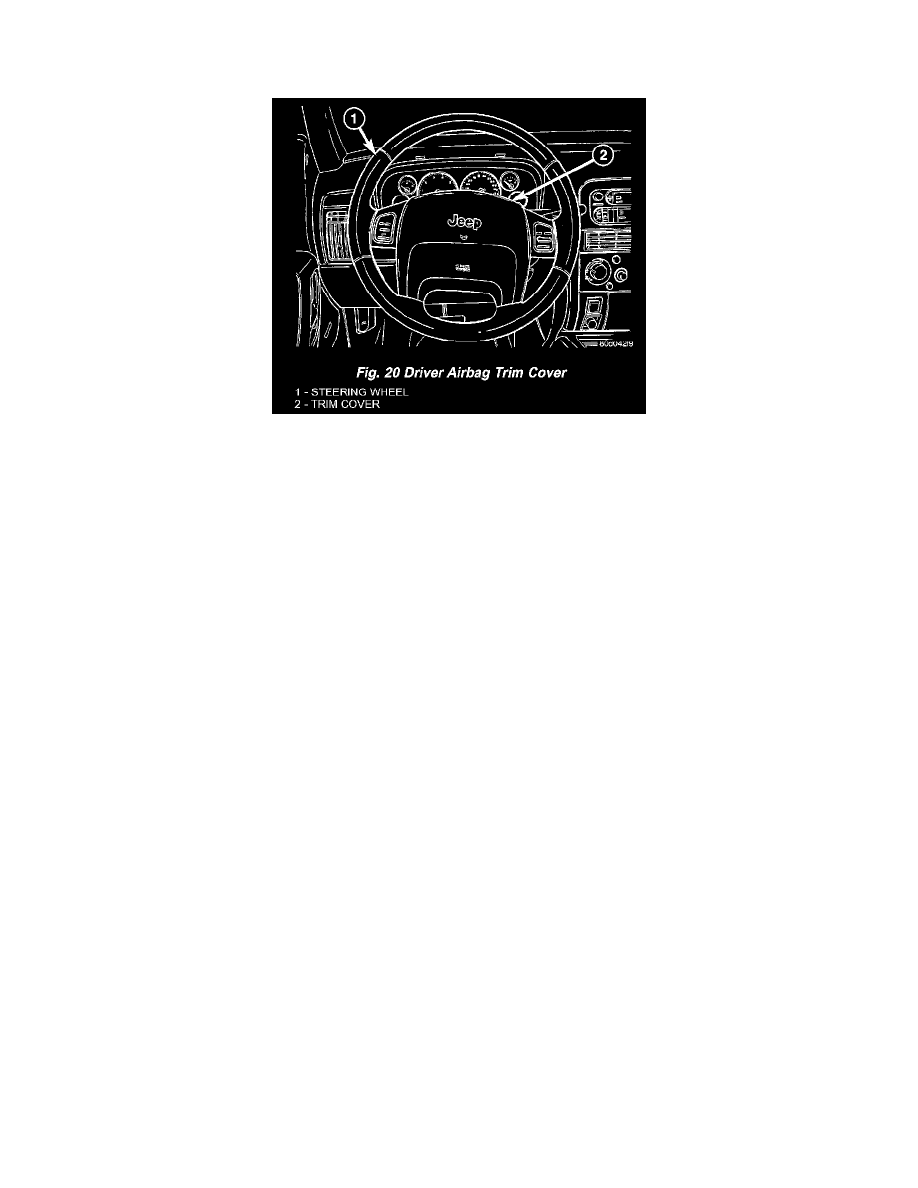Grand Cherokee 4WD V8-4.7L (2003)

Air Bag: Description and Operation
Driver/Passenger Airbags
Fig. 20 Driver Airbag Trim Cover
DRIVER AIRBAG
The injection molded, thermoplastic driver airbag protective trim cover is the most visible part of the driver airbag. The driver airbag is located in the
center of the steering wheel, where it is secured with two screws to the two horizontal spokes of the four-spoke steering wheel armature. A stamped,
satin polished emblem with the Jeep logo is applied to the center of the trim cover. Concealed beneath the driver airbag trim cover are the horn switch,
the folded airbag cushion, the airbag cushion retainer, the airbag housing, the airbag inflator, and the retainers that secure the inflator to the airbag
housing.
The airbag cushion, housing, and inflator are secured within an integral receptacle molded into the back of the trim cover. Locking blocks molded into
the back of the trim cover around the receptacle engage a lip formed around the perimeter of the airbag housing stamping. Two stamped metal
retainers then fit over the inflator mounting studs on the back of the airbag housing and are engaged in slots within the upper and lower trim cover
locking blocks, securely locking the cover into place.
The resistive membrane-type horn switch is secured within a plastic tray that is inserted in a pocket or pouch sewn onto the airbag cushion retainer
strap, between the trim cover and the folded airbag cushion. The horn switch ground pigtail wire has an eyelet terminal connector that is captured on
the upper right inflator mounting stud between the inflator and the upper trim cover retainer. The horn switch feed pigtail wire has a white, molded
plastic insulator that is secured by an integral retainer to a mounting hole located in the upper trim cover retainer near the upper left corner on the back
of the airbag housing, and is connected to the vehicle electrical system through a take out and connector of the steering wheel wire harness.
The airbag used in this model is a multistage, Next Generation-type that complies with revised federal airbag standards to deploy with less force than
those used in some prior models. A radial deploying fabric airbag cushion with internal tethers is used. The airbag inflator is a dual-initiator,
non-azide, pyrotechnic-type unit with four mounting studs and is secured to the stamped metal airbag housing using four hex nuts with washers. Two
keyed and color- coded connector receptacles on the driver airbag inflator connect the two inflator initiators to the vehicle electrical system through
two yellow-jacketed, two-wire pigtail harnesses of the clockspring. The driver airbag cannot be repaired, and must be replaced if deployed or in any
way damaged. The driver airbag trim cover and the horn switch are available for individual service replacement.
The multistage driver airbag is deployed by electrical signals generated by the Airbag Control Module (ACM) through the driver airbag squib 1 and
squib 2 circuits to the two initiators in the airbag inflator. By using two initiators, the airbag can be deployed at multiple levels of force. The force
level is controlled by the ACM to suit the monitored impact conditions by providing one of four delay intervals between the electrical signals provided
to the two initiators. The longer the delay between these signals, the less forcefully the airbag will deploy
When the ACM sends the proper electrical signals to each initiator, the electrical energy generates enough heat to initiate a small pyrotechnic charge
which, in turn ignites chemical pellets within the inflator. Once ignited, these chemical pellets burn rapidly and produce a large quantity of inert gas.
The inflator is sealed to the back of the airbag housing and a diffuser in the inflator directs all of the inert gas into the airbag cushion, causing the
cushion to inflate. As the cushion inflates, the driver airbag trim cover will split at predetermined breakout lines, then fold back out of the way along
with the horn switch and tray unit. Following an airbag deployment, the airbag cushion quickly deflates by venting the inert gas towards the instrument
panel through vent holes within the fabric used to construct the back (steering wheel side) panel of the airbag cushion.
Some of the chemicals used to create the inert gas may be considered hazardous while in their solid state before they are burned, but they are securely
sealed within the airbag inflator. Typically, both initiators are used and all potentially hazardous chemicals are burned during an airbag deployment
event. However, it is possible for only one initiator to be used during a deployment due to an airbag system fault; therefore, it is necessary to always
